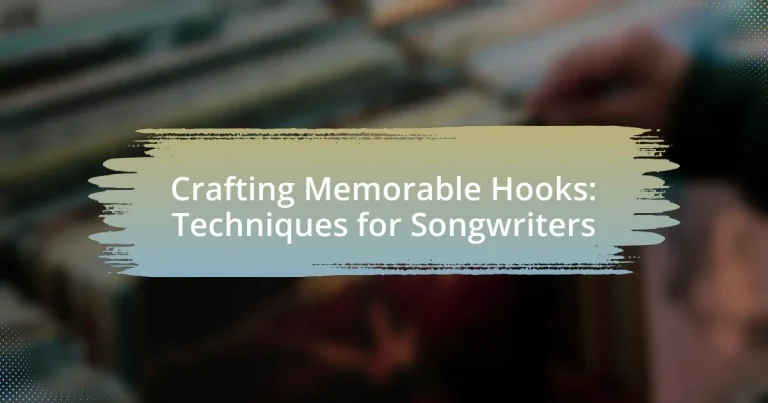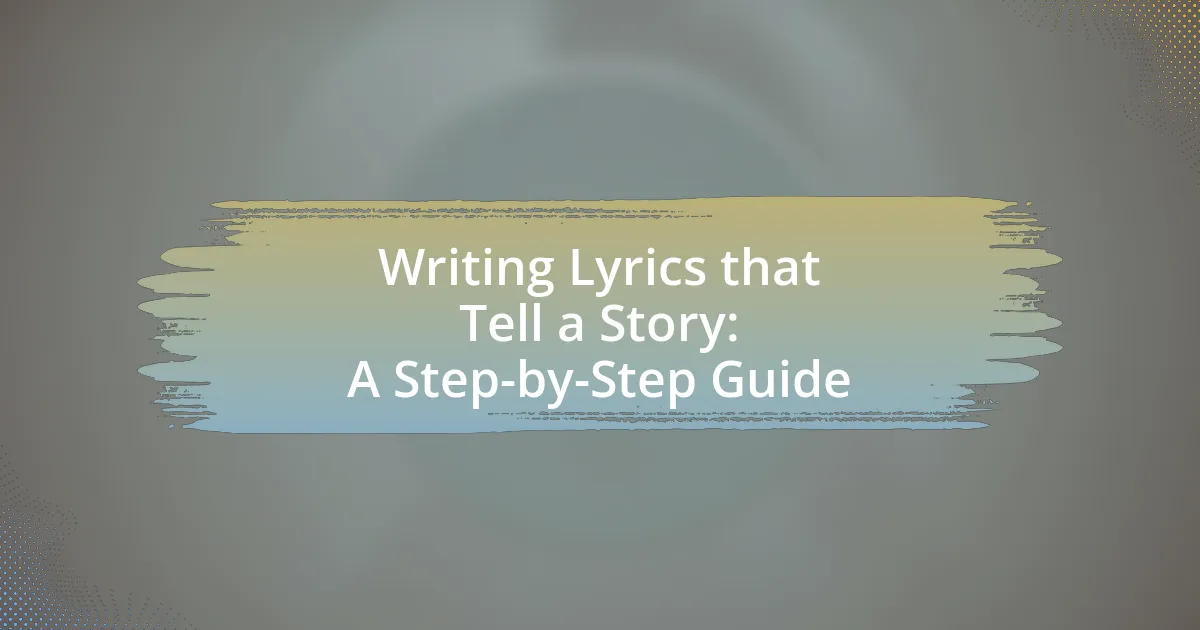Crafting memorable hooks is essential for songwriters aiming to create engaging and commercially successful music. This article explores the significance of hooks in songwriting, detailing their role in listener engagement, song structure, and emotional impact. It discusses techniques for creating effective hooks, including the use of repetition, melodic simplicity, and relatable lyricism, while also highlighting the importance of testing and refining hooks through audience feedback. Additionally, the article addresses common pitfalls to avoid and best practices for balancing originality with familiarity in hook creation.

What are Memorable Hooks in Songwriting?
Memorable hooks in songwriting are catchy musical phrases or lyrical lines that capture the listener’s attention and make a song recognizable. These hooks often serve as the focal point of a song, making it easier for audiences to remember and sing along. Research indicates that songs with strong hooks tend to perform better commercially; for example, a study by the University of Southern California found that songs with memorable hooks are more likely to be streamed and shared. This highlights the importance of crafting hooks that resonate emotionally and musically with listeners.
Why are Hooks Important in Songs?
Hooks are important in songs because they capture the listener’s attention and create memorable moments that enhance the overall appeal of the music. A well-crafted hook serves as a focal point, making the song more engaging and increasing its chances of commercial success. Research indicates that songs with strong hooks are more likely to be played repeatedly on radio and streaming platforms, leading to higher chart performance. For example, a study by the University of Southern California found that songs with catchy hooks tend to have longer play durations and greater listener retention, demonstrating their effectiveness in the music industry.
How do Hooks Influence Listener Engagement?
Hooks significantly enhance listener engagement by creating memorable and catchy elements that capture attention. Research indicates that songs with strong hooks can increase listener retention and replay value, as they often evoke emotional responses and facilitate sing-along moments. For example, a study published in the Journal of Experimental Psychology found that melodies with repetitive and catchy hooks lead to higher recall rates among listeners, demonstrating their effectiveness in maintaining interest and encouraging repeated listening.
What Role do Hooks Play in Song Structure?
Hooks serve as the central element in song structure, designed to capture the listener’s attention and make the song memorable. They typically appear in the chorus or as a repeated phrase, creating a focal point that enhances emotional engagement and aids in retention. Research indicates that songs with strong hooks are more likely to achieve commercial success, as they resonate with audiences and encourage repeated listening. For example, a study by the University of Southern California found that songs with catchy hooks had a higher likelihood of chart performance, demonstrating their critical role in the overall effectiveness of a song.
What Makes a Hook Memorable?
A memorable hook is characterized by its simplicity, catchiness, and emotional resonance. Simplicity allows listeners to easily remember and sing along, while catchiness ensures that the hook sticks in their minds. Emotional resonance connects the hook to the listener’s feelings or experiences, making it relatable. Research indicates that hooks that incorporate repetition and strong melodic elements are more likely to be retained by listeners, as demonstrated in studies on music cognition, such as those by Huron (2006) in “Sweet Anticipation: Music and the Psychology of Expectation.” This combination of factors contributes to the overall memorability of a hook in songwriting.
How do Melody and Rhythm Contribute to Hook Memorability?
Melody and rhythm significantly enhance hook memorability by creating emotional resonance and facilitating recall. A catchy melody often employs simple, repetitive patterns that are easier for listeners to remember, while rhythm provides a structured framework that guides the listener’s engagement. Research indicates that melodies with fewer notes and clear intervals are more likely to be retained in memory, as demonstrated in studies on musical cognition. Additionally, rhythmic elements, such as syncopation or a strong backbeat, can create a sense of movement and excitement, further embedding the hook in the listener’s mind. This combination of melodic simplicity and rhythmic drive is essential for crafting hooks that resonate and stick with audiences.
What Emotional Elements Enhance a Hook’s Impact?
Emotional elements that enhance a hook’s impact include relatability, surprise, and nostalgia. Relatability allows listeners to connect personally with the lyrics, making the hook resonate on a deeper level; for instance, songs that address universal themes like love or heartbreak often become more memorable. Surprise captures attention by introducing unexpected twists or contrasts, which can evoke strong emotional reactions; research shows that surprising elements in music can increase listener engagement. Nostalgia taps into fond memories, creating a sense of familiarity and comfort, which can evoke powerful emotions and enhance the overall appeal of the hook. These emotional elements collectively contribute to a hook’s effectiveness in engaging listeners and making it memorable.

What Techniques Can Songwriters Use to Craft Hooks?
Songwriters can use techniques such as repetition, melodic simplicity, and emotional resonance to craft effective hooks. Repetition helps reinforce the hook in the listener’s memory, making it more likely to be remembered; for example, many popular songs utilize a repeated phrase or melody to create familiarity. Melodic simplicity ensures that the hook is easy to sing along to, which is crucial for audience engagement; studies show that catchy melodies often have fewer notes and straightforward rhythms. Emotional resonance connects the hook to the listener’s feelings, enhancing its impact; research indicates that songs that evoke strong emotions tend to be more memorable and shareable.
How Can Songwriters Use Repetition Effectively?
Songwriters can use repetition effectively by incorporating memorable phrases or hooks throughout their songs to enhance listener retention and emotional impact. This technique allows key themes or emotions to resonate, making the song more engaging. Research indicates that songs with repeated elements, such as choruses or refrains, are more likely to be remembered and sung along to, as evidenced by studies showing that familiarity increases listener enjoyment and connection. For instance, popular songs often utilize repetition in their choruses, which reinforces the central message and creates a sense of unity within the track.
What are the Benefits of Repeating Phrases in Hooks?
Repeating phrases in hooks enhances memorability and emotional impact. This technique reinforces key themes, making them more recognizable and relatable to listeners. Studies in music psychology indicate that repetition aids in information retention, as repeated exposure increases familiarity and preference, leading to a stronger connection with the audience. For instance, popular songs often utilize repeated hooks to create catchiness, which is a crucial factor in their commercial success.
How Does Repetition Affect Listener Recall?
Repetition significantly enhances listener recall by reinforcing memory retention. When a phrase or melody is repeated, it creates familiarity, which aids in encoding information into long-term memory. Research indicates that repeated exposure to specific auditory stimuli increases the likelihood of recall; for instance, a study published in the Journal of Experimental Psychology found that participants were more likely to remember repeated words compared to those presented only once. This principle is particularly relevant in songwriting, where memorable hooks often rely on repetition to ensure that listeners can easily remember and sing along.
What Role Does Lyricism Play in Hook Creation?
Lyricism plays a crucial role in hook creation by providing memorable and relatable phrases that resonate with listeners. Effective hooks often utilize concise, impactful lyrics that encapsulate the song’s theme, making them easy to remember and sing along to. For instance, songs like “I Will Always Love You” by Whitney Houston feature hooks that are both emotionally charged and lyrically simple, enhancing their memorability. This connection between lyricism and hook effectiveness is supported by studies showing that songs with strong lyrical hooks tend to achieve higher chart success, indicating that well-crafted lyrics significantly contribute to a song’s overall appeal and listener retention.
How Can Imagery and Metaphors Strengthen a Hook?
Imagery and metaphors can strengthen a hook by creating vivid mental pictures and emotional connections that engage listeners immediately. When songwriters use imagery, they evoke sensory experiences that make the lyrics more relatable and memorable. For example, a metaphor like “drowning in a sea of sorrow” not only conveys deep emotion but also allows listeners to visualize and feel the weight of that sorrow. Research in cognitive linguistics shows that metaphors shape how we understand and relate to concepts, making them powerful tools in songwriting. By employing these techniques, songwriters can craft hooks that resonate on multiple levels, enhancing the overall impact of their music.
What Techniques Help Create Catchy Lyrics?
Techniques that help create catchy lyrics include the use of repetition, rhyme schemes, and strong imagery. Repetition reinforces key phrases, making them memorable; for example, the chorus of a song often repeats to enhance recall. Rhyme schemes create a musical quality that engages listeners, as seen in popular songs where end rhymes contribute to a rhythmic flow. Strong imagery evokes emotions and paints vivid pictures, allowing listeners to connect with the song on a deeper level. These techniques are widely recognized in songwriting, as evidenced by the success of numerous chart-topping hits that employ them effectively.

How Can Songwriters Test and Refine Their Hooks?
Songwriters can test and refine their hooks by gathering feedback from diverse audiences and utilizing digital tools for analysis. Engaging listeners through live performances or online platforms allows songwriters to observe reactions and identify which hooks resonate most. Additionally, using software that analyzes song structure and melody can provide insights into the effectiveness of a hook. Research indicates that songs with memorable hooks often have a strong emotional connection, which can be assessed through audience engagement metrics such as shares and likes on social media. This combination of direct feedback and analytical tools enables songwriters to make informed adjustments to enhance their hooks.
What Methods Can Be Used to Gather Feedback on Hooks?
Methods to gather feedback on hooks include focus groups, online surveys, and social media polls. Focus groups allow songwriters to present their hooks to a selected audience and receive immediate reactions, which can provide qualitative insights into the effectiveness of the hooks. Online surveys can reach a broader audience, enabling songwriters to collect quantitative data on listener preferences and perceptions. Social media polls offer a quick and interactive way to gauge audience reactions, allowing songwriters to test multiple hooks and see which resonates best. These methods are effective as they leverage direct audience engagement, providing actionable feedback that can enhance the songwriting process.
How Can Focus Groups Help in Hook Evaluation?
Focus groups can significantly aid in hook evaluation by providing direct feedback from target audiences regarding their emotional and cognitive responses to musical hooks. This qualitative research method allows songwriters to gather diverse perspectives, which can reveal what resonates with listeners and what does not. For instance, a study published in the Journal of Music Theory found that audience engagement is often influenced by specific melodic and lyrical elements, which focus groups can help identify. By analyzing group discussions and reactions, songwriters can refine their hooks to enhance appeal and memorability, ultimately increasing the likelihood of commercial success.
What Tools Are Available for Analyzing Hook Effectiveness?
Tools available for analyzing hook effectiveness include music analytics software, audience feedback platforms, and A/B testing tools. Music analytics software, such as Spotify for Artists and Soundcharts, provides data on listener engagement and streaming metrics, allowing songwriters to assess how well their hooks resonate with audiences. Audience feedback platforms like Feedback Loop and SurveyMonkey enable songwriters to gather direct responses from listeners regarding specific hooks. A/B testing tools, such as Google Optimize, allow for experimentation with different hook variations to determine which version performs better in terms of listener retention and engagement. These tools collectively offer valuable insights into the effectiveness of hooks in songwriting.
What Best Practices Should Songwriters Follow When Crafting Hooks?
Songwriters should focus on simplicity, catchiness, and emotional resonance when crafting hooks. A simple hook is easier for listeners to remember and sing along to, which is supported by the fact that many successful songs feature repetitive and straightforward phrases. Catchiness can be enhanced through the use of rhythmic patterns and melodic contours that engage the listener, as evidenced by the prevalence of hooks in popular music that utilize these techniques. Additionally, hooks that evoke strong emotions tend to resonate more deeply with audiences, leading to greater connection and memorability, as shown in studies highlighting the impact of emotional content on listener engagement.
How Can Songwriters Balance Originality and Familiarity in Hooks?
Songwriters can balance originality and familiarity in hooks by incorporating unique melodic elements while using common chord progressions and lyrical themes. This approach allows songwriters to create memorable hooks that resonate with listeners, as familiar structures provide a sense of comfort while original melodies capture attention. Research indicates that songs with a blend of novelty and familiarity tend to perform better on charts, as they engage listeners without alienating them. For example, the use of the I-IV-V chord progression is prevalent in popular music, yet artists like Taylor Swift and Ed Sheeran have successfully introduced distinctive melodies within these frameworks, demonstrating that originality can thrive alongside familiarity.
What Common Mistakes Should Be Avoided in Hook Creation?
Common mistakes to avoid in hook creation include being overly complex, lacking emotional resonance, and failing to align with the song’s theme. Overly complex hooks can confuse listeners, making them less memorable; simplicity often enhances recall. Emotional resonance is crucial, as hooks that evoke feelings tend to engage audiences more effectively. Additionally, hooks that do not align with the song’s overall theme can create dissonance, leading to a disconnect with the listener. For instance, a study by the University of Southern California found that songs with cohesive themes and relatable hooks have higher listener retention rates.





